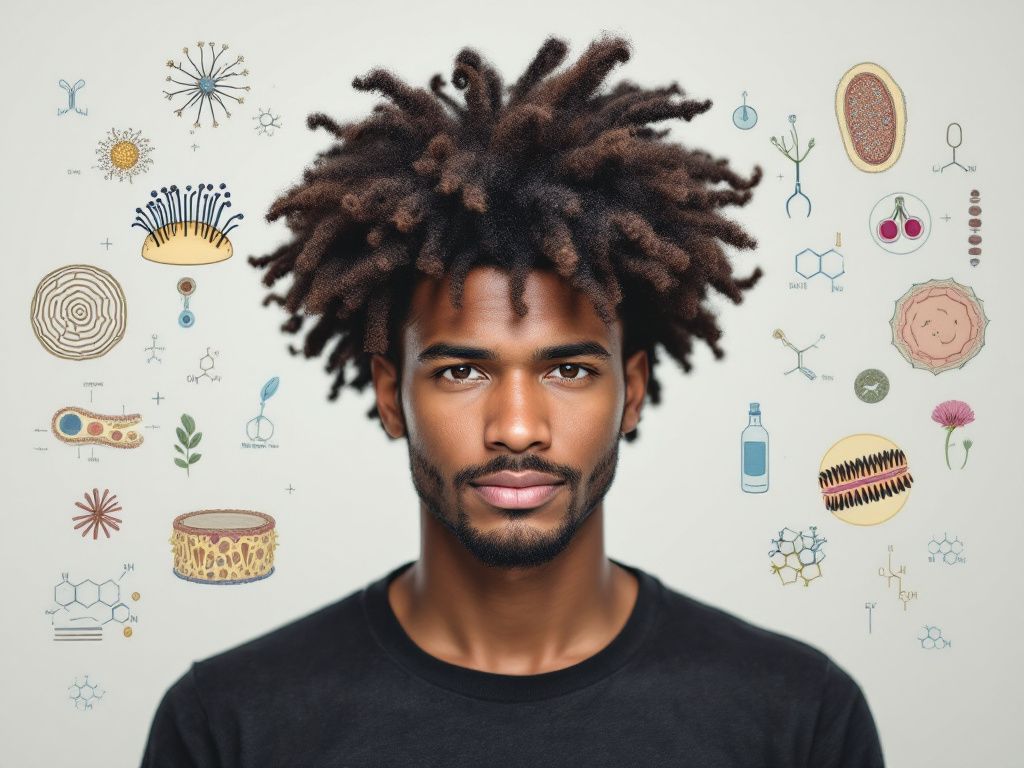
Have you ever wondered why hair can be both sleek and straight or curly and coarse? Understanding the diverse textures of hair not only enriches our knowledge of human biology but also enriches our approach to hair care. The structure of hair is a complex interplay of biology, chemistry, and physics that manifests in the plethora of textures seen around the globe. Dive into the science of hair foilicle structure and explore why our locks can differ so widely—and what that means for the future of personalized hair care.
—
Understanding Hair Structure: The Foundation 🌿
The Anatomy of Hair
At its most basic level, hair is a keratinous filament growing out of the follicle, a complex mini-organ within the skin. These microscopic models of biological complexity are responsible for hair’s texture, color, and growth cycle. Primarily, hair structure can be broken down into three major components:
- Cuticle: The outermost layer, featuring overlapping shingle-like cells. This layer serves to protect the inner structure of the hair from external damage.
- Cortex: The thickest layer of the shaft, rich in fibrous proteins like keratin. The cortex is where strength, elasticity, texture, and color pigmentation (melanin) reside.
- Medulla: A soft core within some hair types, primarily found in thicker hairs.
The Hair Follicle Complex
The hair follicle is an intricate tunnel-shaped structure in the epidermis. Its role in determining hair texture lies heavily in its shape and size:
- Follicle Shape: The circular or oval shape of the hair follicle determines if hair shafts will be straight, wavy, or curly. Round follicles typically produce straight hair, whereas oval follicles result in wavy curls, and more elliptically shaped follicles create tightly coiled curls.
- Follicle Size: This dictates the thickness of individual strands, contributing to volume and texture perception.
A review study released in the “Journal of Investigative Dermatology” pointed out that genetic coding strictly controls follicular morphology, which directly influences hair structure.

—
The Role of Keratin Proteins: Chemical Backbone 🧬
Keratin Structure and Function
Keratin, a type of hard sulfur-containing protein, is the key building block of hair. It exists in two primary forms: alpha-keratins and beta-keratins. Alpha-keratins predominate in human hair, forming helical structures that confer structural integrity and resilience.
- Helical Configuration: Stories encoding the coil structure intertwine to form protofibrils, an assembly that strengthens the hair fiber mechanically.
- Disulfide Bonds: These determine rigidity and are pivotal in the diversity of hair textures. Disulfide bonds between keratin molecules can stretch or compress depending on genetic factors, thermal styling, or chemical treatments.
Keratin and Hair Biology
Changes in the levels and distribution of keratin lead to varied hair resilience and texture. Enzymes like keratinase can biologically degrade keratin, showing potential applications in developing more nuanced hair care products.
Industry Insights
Companies like Unilever are exploring keratin nanotechnology to aid in hair repair and strengthening treatments. With haircare as a billion-dollar industry, understanding keratin’s role offers a tangible route toward innovative product development.
—
Genetic Influences: Mapping the Diversity 🧬

A Genetic Blueprint
Hair texture results from an orchestra of genetic factors. One pivotal gene, **TCHH (trichohyalin)**, affects hair shape by influencing the internal structure of the hair cortex. The “Nature Genetics” journal highlights studies examining thousands of subjects, illustrating TCHH variations’ role in texture diversity.
Twin Studies: Nature vs. Nurture
Research shows that identical twins often exhibit extraordinarily similar hair patterns, validating the substantial impact of genetics. These studies argue against environmental impacts on altering curl, asserting that twin distinctions usually pertain to external hair treatment rather than texture genesis.
—
Ethnic and Evolutionary Perspectives 🌍
Evol From An Evolutionary Lensutionary Adaptations
The vast array of hair textures has an evolutionary element. As homo sapiens migrated, hair morphed adaptively:
- Thick, Coiled Hair evolved in equatorial regions, providing a shield against intense UV radiation.
- Fine, Straight Hair was advantageous in colder climes, offering more coverage per follicle, conserving body heat.
Researchers published in the “American Journal of Physical Anthropology” elaborate on how these texture differences were key survival mechanisms.
Cross-Population Studies
Data show particular geographic concentrations, with high-density curly hair prevalent among African descendants and straighter hair among East Asian populations. Understanding these genetic markers permits enhancements in dermatological studies and targeted cosmetic formulations.
—

Practical Implications and Hair Care Applications 🧴
Texture-Specific Hair Care
While a flourishing industry caters to ‘one-size-fits-all’ products, significant improvement is observed in texture-targeted formulations:
- Straight Hair: Is more susceptible to oily build-up due to rapid sebum travel along the shaft. Honey-based cleansers can moderate oil without stripping necessary natural oils.
- Curly Hair: Solvent-free conditioners can maintain hydration in porous hair types. Argan and shea oils are beneficial for texture definition and frizz control.
Innovations in Hair Styling Technology
The understanding of hair structure and keratin integrity has inspired:
- Heat Styling Tools: Incorporating even heat distribution technology, these ensure cleaner seals on the cuticle.
- Chemical Treatments: Japanese thermal straightening and Brazilian Blowouts have learned to adjust keratin bond integrity to lengthen the straightening effects while minimizing damage risks.
The Future: Personalization in Cosmetic Formulations
Consumer consciousness about ingredient efficacy and safety is burgeoning. Utilizing personal genomic data allows industry experts to craft precise, effective formulas—for not just beauty, but hair health.
—
Conclusion: The Science of Beauty
Hair isn’t just about aesthetic appeal—it’s a testament to a spectacular, nuanced biological process. Understanding the science behind the formation of different hair textures enhances not only our beauty routines but cultural sensitivity and appreciation for evolutionary biology. As the science underlying hair structure evolves, so too will our capabilities to tailor healthcare solutions meeting individual needs, truly cementing the integration of biology and beauty. 👩🔬
The progress in hair structure science continues to illuminate optimal approaches to hair care that respect genetic diversity and biological complexity—changed for a world that increasingly looks to tailor solutions and embrace inclusivity in everything from research to treatment.
Frequently Asked Questions
What are the benefits of using a hair mask in my hair care routine?
Using a hair mask can provide several benefits, including hydration, smoothing, strengthening, curl definition, heat protection, and damage repair. Hair masks infuse the hair with moisture, help coat the hair shaft to seal split ends, reduce breakage, and protect the hair from heat styling and environmental damage[1][4].
What ingredients should I look for in a hair mask?
Effective hair masks often include ingredients such as coconut oil, argan oil, shea butter, honey, avocado oil, green tea, and coconut water. These ingredients provide nourishment, moisturize, and protect the hair, offering benefits like softening, moisturizing, and protecting against damage[2][5].
How often should I use a hair mask in my routine?
You should use a hair mask whenever your hair feels dry, unmanageable, or in need of intense hydration. This can vary depending on your hair type and needs, but generally, using a hair mask once or twice a week can help maintain healthy and moisturized hair[1][4].
How do I apply a hair mask for the best results?
To apply a hair mask effectively, shampoo your hair first, then apply the mask, focusing especially on the ends where hair tends to be the most damaged. Leave the mask on for anywhere from 10 minutes to overnight, depending on the type of mask and your hair’s needs[1][4].
References


Leave a Reply